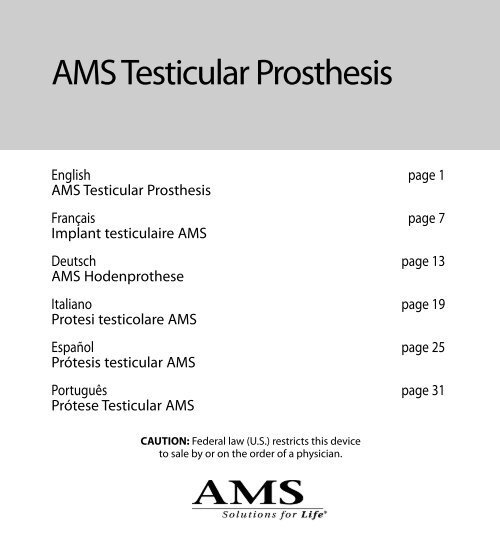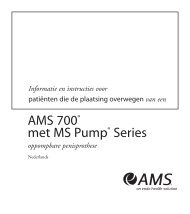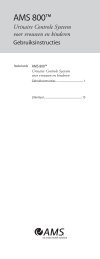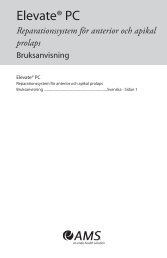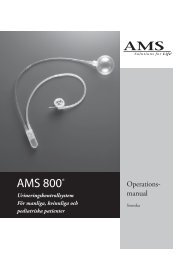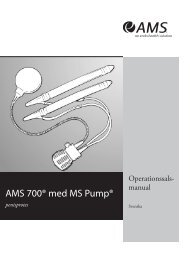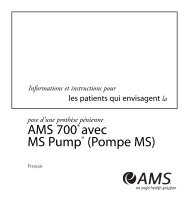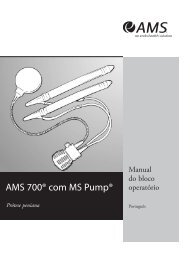23300088_Testicular Prosthesis IFU_0409 - AMS Labeling ...
23300088_Testicular Prosthesis IFU_0409 - AMS Labeling ...
23300088_Testicular Prosthesis IFU_0409 - AMS Labeling ...
Create successful ePaper yourself
Turn your PDF publications into a flip-book with our unique Google optimized e-Paper software.
<strong>AMS</strong> <strong>Testicular</strong> <strong>Prosthesis</strong><br />
English page 1<br />
<strong>AMS</strong> <strong>Testicular</strong> <strong>Prosthesis</strong><br />
Français page 7<br />
Implant testiculaire <strong>AMS</strong><br />
Deutsch page 13<br />
<strong>AMS</strong> Hodenprothese<br />
Italiano page 19<br />
Protesi testicolare <strong>AMS</strong><br />
Español page 25<br />
Prótesis testicular <strong>AMS</strong><br />
Português page 31<br />
Prótese <strong>Testicular</strong> <strong>AMS</strong><br />
CAUTION: Federal law (U.S.) restricts this device<br />
to sale by or on the order of a physician.
European Union (EU)<br />
Authorized Representative:<br />
American Medical Systems<br />
Europe B.V.<br />
Straatweg 66H<br />
3621 BR Breukelen<br />
The Netherlands<br />
Tel: + 31 (0) 346 258 100<br />
Fax: + 31 (0) 346 258 130<br />
Contact List:<br />
American Medical Systems U.S.A.<br />
10700 Bren Road West<br />
Minnetonka, MN 55343<br />
U.S.A.<br />
Tel: + 952 930 6000<br />
Fax: + 952 930 6157<br />
American Medical Systems<br />
Australia Pty Ltd.<br />
Unit 39, Building F<br />
16 Mars Road<br />
Lane Cove NSW 2066<br />
Australia<br />
Tel: + 61 2 9425 6800<br />
Fax: + 61 2 9427 6296<br />
American Medical Systems<br />
Canada Inc.<br />
P.O. Box 461<br />
Guelph, Ontario N1H 6K9<br />
Canada<br />
Tel: + 519 826 5333<br />
Fax: + 519 821 1356<br />
American Medical Systems<br />
Deutschland GmbH<br />
Voßstr. 20<br />
D-10117 Berlin<br />
Germany<br />
Tel: + 49 (0) 30 20 64390<br />
Fax: + 49 (0) 30 20 643999<br />
American Medical Systems France<br />
19 avenue de Norvège<br />
Les Fjords - Bâtiment Nobel<br />
91953 Courtaboeuf Cedex<br />
France<br />
Tel: + 33 (0) 1 69 59 97 00<br />
Fax: + 33 (0) 1 69 59 97 29<br />
American Medical Systems<br />
Ibérica S.L.<br />
c/Joaquin Turina, 2 Planta primera - Oficina 6<br />
28224 Pozuelo de Alarcón (Madrid)<br />
Spain<br />
Tel: + 34 (0) 91 799 49 70<br />
Fax: + 34 (0) 91 715 75 26<br />
American Medical Systems U.K. Ltd.<br />
Capital Court<br />
Capital Interchange Way<br />
Brentford<br />
TW8 0EX<br />
United Kingdom<br />
Tel: + 44 (0) 20 8996 3100<br />
Fax: + 44 (0) 20 8995 3720
<strong>AMS</strong> <strong>Testicular</strong> <strong>Prosthesis</strong><br />
English<br />
Description<br />
The <strong>AMS</strong> <strong>Testicular</strong> <strong>Prosthesis</strong> consists of a silicone elastomer<br />
designed in a shape to simulate the testicle within the male<br />
scrotum. The prosthesis is provided sterile and is available in<br />
three sizes. Each implant has a suture hole to facilitate placement.<br />
A<br />
B<br />
Dimensions (mm)<br />
Reference Size A B<br />
72403400 8.69cc (Small) 31 23<br />
72403401 15.24cc (Medium) 37 28<br />
72403402 22.45cc (Large) 42 32<br />
Indications for Use<br />
The <strong>AMS</strong> <strong>Testicular</strong> <strong>Prosthesis</strong> is for cosmetic replacement of a<br />
testicle.<br />
Contraindications<br />
The implantation of this prosthesis is contraindicated in patients<br />
who have active urogenital infections or active skin infections in<br />
the region of surgery.<br />
1
Precautions<br />
• Migration of the prosthesis may occur if the prosthesis is not<br />
sutured in place.<br />
• Use of an oversized prosthesis for the existing scrotal pocket<br />
may result in necrosis and subsequent extrusion.<br />
• The implantation of this prosthesis should only be considered in<br />
patients whom the physician determines are adequate surgical<br />
candidates.<br />
• A thorough preoperative consulta tion should include a<br />
discussion between patient and physician of all available<br />
treatment options and their risks and benefits.<br />
Warnings<br />
This prosthesis contains a silicone elastomer. The risks and<br />
benefits of implanting this prosthesis in patients with documented<br />
sensitivity to silicone should be carefully considered.<br />
Silicone Information<br />
This prosthesis is composed of a silicone elastomer. Silicone gel is<br />
not a component in the materials of this prosthesis.<br />
Silicone elastomers have been commonly used in a variety of<br />
biomedical devices for over 40 years and are used as a<br />
biocompatibility reference against which new materials are tested.<br />
Silicone elastomers have an extensive history of use in medical<br />
devices.<br />
Scientific literature has included reports of adverse events and<br />
other observations in patients with implantable silicone devices.<br />
2
As reported, these events/observations indicate "allergic-like"<br />
symptoms and in other cases a symptom complex associated with<br />
immunological disorders. No causal relationship has been<br />
established between these events and silicone elastomer.<br />
There are reports of malignant tumor formation in laboratory<br />
animals only, not humans, associated with implants of relative<br />
large size. Many different materials are associated with this effect<br />
in animals, silicone elastomers among them. No such effect has<br />
been described in humans.<br />
Extensive testing has been conducted on all materials that<br />
comprise the <strong>AMS</strong> <strong>Testicular</strong> <strong>Prosthesis</strong>. This testing has<br />
demonstrated biocompatability consistent with accepted<br />
standards.<br />
How Supplied and Storage<br />
WARNING: Contents supplied STERILE. Do not use if sterile<br />
barrier is damaged. If damage is found, call your <strong>AMS</strong><br />
representative.<br />
For single patient use only. Do not reuse, reprocess or<br />
resterilize. Reuse, reprocessing or resterilization may compromise<br />
the structural integrity of the device and/or lead to device failure<br />
which, in turn, may result in patient injury, illness or death. Reuse,<br />
reprocessing or resterilization may also create a risk of<br />
contamination of the device and/or cause patient infection or<br />
cross-infection, including, but not limited to, the transmission of<br />
infectious disease(s) from one patient to another. Contamination<br />
of the device may lead to injury, illness or death of the patient.<br />
3
After use, dispose of product and packaging in accordance with<br />
hospital, administrative and/or local government policy.<br />
Instructions For Use<br />
These instructions are not intended to be a complete reference.<br />
Patient Preparation<br />
• The physician must evaluate the surgical approach most<br />
appropriate for the patient and physician’s training and<br />
experience.<br />
• Before the surgery, the physician should take adequate steps to<br />
limit the risk of post-operative infection.<br />
• Once in the operating room, the patient should be prepped<br />
following an approved hospital preoperative scrub procedure.<br />
The patient should be positioned so that the preferred type of<br />
incision can be made.<br />
Unpacking Components<br />
1. Keep the sterile tray in the dustcover until the prosthesis is in<br />
the operating room.<br />
2. Remove the tray from the dustcover box in the operating room<br />
by opening the end of the dustcover.<br />
3. Remove the inner tray from the outer tray using appropriate<br />
sterile technique. Hold the outer tray without touching the<br />
sterile inner tray. The scrub nurse removes the sterile inner tray<br />
and places it on a sterile, lint free stand.<br />
4
4. When ready to implant the prosthesis, open the inner tray and<br />
remove the prosthesis. No preparation is required.<br />
Inventory Returns and Product Replacement Information<br />
Customers outside of the United States should contact their local<br />
<strong>AMS</strong> representative prior to returning any product.<br />
This document is written for professional medical audiences.<br />
Contact American Medical Systems for lay publications.<br />
American Medical Systems periodically updates product<br />
literature. If you have any questions about the currency of the<br />
information, contact American Medical Systems.<br />
5
Implant testiculaire <strong>AMS</strong><br />
Français<br />
Description<br />
L’implant testiculaire <strong>AMS</strong>, composé d’un caoutchouc de silicone,<br />
simule, de par sa forme, le testicule à l’intérieur du scrotum chez<br />
l’homme. Cette prothèse est livrée stérile et est disponible dans<br />
trois tailles. Chaque implant est muni d’un orifice de suture pour<br />
faciliter la mise en place.<br />
A<br />
B<br />
Dimensions (mm)<br />
Référence Taille A. B.<br />
72403400 8.69cc (Small) 31 23<br />
72403401 15.24cc (Medium) 37 28<br />
72403402 22.45cc (Large) 42 32<br />
Indications<br />
L’ implant testiculaires <strong>AMS</strong> est destiné au remplacement du<br />
testicule à des fins purement esthétiques.<br />
Contre-indications<br />
L’implantation de cet implant est contre-indiquée chez les patients<br />
souffrant d’infections génito-urinaires évolutives ou d’infections<br />
7
cutanées évolutives de la région concernée par l’intervention<br />
chirurgicale.<br />
Précautions<br />
• Une migration de l’implant peut survenir s’il n’est pas suturé en<br />
position.<br />
• L’emploi d’un implant surdimensionné par rapport à la bourse<br />
testiculaire du patient peut causer une nécrose et une expulsion<br />
ultérieure.<br />
• L’implantation de cet implant ne devra être envisagée que chez<br />
les patients jugés par le médecin comme candidats acceptables<br />
pour cette intervention.<br />
• Dans le cadre d’une consultation préopératoire approfondie, il<br />
est souhaitable que le patient puisse discuter avec son médecin<br />
des différentes options de traitement possibles, de leurs risques<br />
et avantages respectifs.<br />
Avertissements<br />
Cet implant contient du caoutchouc de silicone. Il est conseillé<br />
d’évaluer avec soin les avantages et les inconvénients de son<br />
implantation chez les patients présentant une sensibilité connue<br />
au silicone.<br />
Informations concernant le silicone<br />
Cet implant est composé de caoutchouc de silicone. Le gel de<br />
silicone n’entre pas dans sa fabrication.<br />
Les caoutchoucs de silicone sont couramment utilisés dans la<br />
fabrication de dispositifs biomédicaux depuis plus de 40 ans et<br />
8
servent de référence pour les essais de bio compatibilité de<br />
nouveaux matériaux. Les caoutchoucs de silicone sont très<br />
largement utilisés dans les appareils médicaux.<br />
Les publications scientifiques rendent compte de manifestations<br />
indésirables et autres effets chez les patients porteurs d’implants<br />
en silicone. Tels qu’ils sont décrits, ces effets ou manifestations<br />
suggèrent des symptômes “de type allergique” et, dans d’autres<br />
cas, un ensemble de symptômes associés à des troubles<br />
immunologiques. Aucune relation de cause à effet n’a été établie<br />
entre ces manifestations et le caoutchouc de silicone.<br />
D’autres publications font également état, non pas chez l’homme<br />
mais chez des animaux en laboratoire, d’une formation de tumeurs<br />
malignes liée à des implants de dimension relativement<br />
importante. De nombreux matériaux différents, dont les<br />
caoutchoucs de silicone, sont associés à cet effet chez l’animal.<br />
Aucun effet semblable n’a été décrit chez l’homme.<br />
Tous les matériaux entrant dans la fabrication des implants<br />
testiculaires <strong>AMS</strong> ont été rigoureusement testés. Ces tests ont<br />
permis de démontrer l’existence d’une bio compatibilité conforme<br />
avec les normes admises.<br />
Présentation et stockage<br />
MISE EN GARDE: Contenu fourni STÉRILE. Ne pas utiliser ce<br />
produit si l’emballage est endommagé. En cas de détérioration,<br />
appeler le représentant <strong>AMS</strong>.<br />
À usage sur un seul patient. Ne pas réutiliser, retraiter ou<br />
restériliser. La réutilisation, le retraitement ou la restérilisation de<br />
9
ce dispositif risquent de compromettre son intégrité structurelle<br />
et/ou d’entraîner son dysfonctionnement, risquant de provoquer<br />
des blessures, des maladies ou le décès du patient. La réutilisation,<br />
le retraitement ou la restérilisation peuvent aussi entraîner la<br />
contamination du dispositif et/ou l’infection croisée du patient, y<br />
compris la transmission de maladies infectieuses d’un patient à un<br />
autre. La contamination du dispositif peut causer des blessures,<br />
des maladies ou le décès du patient. Après utilisation, éliminer le<br />
produit et l’emballage conformément au règlement de<br />
l’établissement, de l’administration et/ou du gouvernement local.<br />
Mode d’emploi<br />
Ces instructions ne constituent pas une source complète de<br />
références.<br />
Préparation du patient<br />
• Il appartient au médecin d’évaluer l’approche chirurgicale à<br />
suivre en fonction de sa formation et de son expérience, ainsi<br />
que de l’état du patient.<br />
• Avant l’intervention, le médecin doit prendre les mesures<br />
nécessaires pour limiter le risque d’une infection postopératoire.<br />
• Dès son arrivée dans la salle d’opération, le patient doit être<br />
préparé selon la procédure de lavage préopératoire suivie par<br />
l’hôpital. Positionner le patient en fonction du type d’incision à<br />
effectuer.<br />
10
Déballage des composants<br />
1. Conserver le plateau stérile dans l’emballage anti-poussière<br />
jusqu’au moment où l’implant se trouve dans la salle<br />
d’opération.<br />
2. Dans la salle d’opération, retirer le plateau de la boîte antipoussière<br />
en ouvrant l’extrémité de l’emballage.<br />
3. Sortir le plateau intérieur du plateau extérieur en suivant une<br />
procédure stérile appropriée. Tenir le plateau extérieur sans<br />
toucher le plateau intérieur stérile. L’instrumentiste retirera le<br />
plateau intérieur stérile et le placera sur un support stérile, non<br />
pelucheux.<br />
4. Lorsque tout est prêt pour l’implantation, ouvrir le plateau<br />
intérieur et retirer la prothèse. Aucune préparation n’est<br />
nécessaire.<br />
Renvoi du matériel et remplacement du produit<br />
Les clients en dehors des Etats-Unis sont invités à contacter le<br />
représentant local d’<strong>AMS</strong> avant tout renvoi de produit.<br />
Ce document s’adresse au corps médical. Des publications à<br />
l’intention du grand public sont disponibles auprès d’American<br />
Medical Systems.<br />
American Medical Systems met régulièrement à jour la<br />
documentation de ses produits. Pour toute question relative à la<br />
fiabilité des présents renseignements, veuillez contacter American<br />
Medical Systems.<br />
11
<strong>AMS</strong> Hodenprothese<br />
Deutsch<br />
Beschreibung<br />
Die Hodenprothese von <strong>AMS</strong> besteht aus Silikonelastomer und ist<br />
so geformt, daß sie die Form des Hodens im Skrotum simuliert.<br />
Die Prothese wird steril geliefert und ist in drei Größen erhältlich.<br />
Die Implantate sind jeweils mit einer Nahtöffnung versehen, um<br />
sie leichter fixieren zu können.<br />
Größenbestimmung<br />
B<br />
A<br />
Abmessungen (mm)<br />
Kat.-Nr. Größe A B<br />
72403400 8.69cc (Small) 31 23<br />
72403401 15.24cc (Medium) 37 28<br />
72403402 22.45cc (Large) 42 32<br />
Indikationen<br />
Die Hodenprothese von <strong>AMS</strong> dient als Hodenersatz für<br />
kosmetische Zwecke.<br />
13
Kontraindikationen<br />
Die Implantation ist bei Patienten mit aktiven urogenitalen<br />
Infektionen und aktiven Hautinfektionen im Operationsgebiet<br />
kontraindiziert.<br />
Vorsichtsmaßnahmen<br />
• Eine Dislokation ist möglich, wenn die Prothese nicht durch<br />
Nähte fixiert wird.<br />
• Die Verwendung einer für das Skrotum zu großen Prothese kann<br />
zur Nekrose und Extrusion führen.<br />
• Die Implantation dieser Prothese sollte nur bei solchen<br />
Patienten erwogen werden, bei denen der Arzt den Einsatz der<br />
Prothese für indiziert hält.<br />
• Eine gründliche präoperative Konsultation mit dem Patienten<br />
sollte eine Diskussion über alle in Frage kommenden<br />
Behandlungs alternativen und ihre jeweiligen Risiken und<br />
Vorteile einschließen.<br />
Warnhinweise<br />
Diese Prothese enthält Silikon elastomer. Risiko und Nutzen einer<br />
Implantation bei Patienten mit nachgewiesener Silikonüber -<br />
empfind lichkeit müssen sorgfältig abgewogen werden.<br />
Silikon<br />
Diese Prothese besteht aus Silikonelastomer. Sie enthält kein<br />
Silikongel.<br />
Silikonelastomere werden seit über 40 Jahren in den<br />
verschiedensten biomedizinischen Implantaten eingesetzt und<br />
14
dienen als Vergleichsmaterial zum Testen der Biokompatibilität<br />
neuer Materialien. Silikonelastomere werden schon seit langem in<br />
Medizinprodukten verwendet.<br />
In der Fachliteratur wurde über unerwünschte Ereignisse bzw.<br />
Wirkungen und andere Beobachtungen bei Patienten mit<br />
Silikonimplantaten berichtet. Den Berichten zufolge deuten diese<br />
Ereignisse bzw. Beobachtungen auf “allergieartige” Symptome<br />
und andernfalls auf einen mit immunologischen Störungen<br />
verbundenen Symptomkomplex hin. Es wurde kein ursächlicher<br />
Zusammenhang zwischen den unerwünschten Ereignissen und<br />
Silikonelastomer hergestellt.<br />
Es liegen Berichte über die Bildung maligner Tumore bei<br />
Versuchstieren (nicht bei Menschen) vor, die in Verbindung mit<br />
relativ großen Implantaten stehen. Viele verschiedene Materialien,<br />
darunter auch Silikonelastomere, rufen solche Wirkungen bei<br />
Tieren hervor. Bei Menschen wurden derartige Wirkungen nicht<br />
beschrieben.<br />
Alle Materialien, die bei der Herstellung von <strong>AMS</strong> Hoden prothesen<br />
verwendet werden, wurden umfangreichen Tests unterzogen. Die<br />
Tests haben eine akzeptable Biokompatibilität ergeben.<br />
Lieferumfang und Aufbewahrung<br />
WARNUNG: Der Inhalt wird STERIL geliefert. Bei beschädigtem<br />
sterilen Verpackungssiegel nicht verwenden. Im Falle von<br />
Beschädigungen Kontakt mit einem Vertreter von <strong>AMS</strong><br />
aufnehmen.<br />
15
Zum Gebrauch an einem einzelnen Patienten. Nicht<br />
wiederverwenden, wiederaufbereiten oder resterilisieren. Die<br />
Wiederverwendung, Wiederaufbereitung oder Resterilisation kann<br />
eine Beeinträchtigung der strukturellen Unversehrtheit der<br />
Vorrichtung und/oder ein Versagen der Vorrichtung zur Folge<br />
haben, was wiederum zu Erkrankungen, Verletzungen oder zum<br />
Tod des Patienten führen kann. Eine Wiederverwendung,<br />
Wiederaufbereitung oder Resterilisation der Vorrichtung erhöht<br />
ebenfalls das Kontaminationsrisiko bzw. das Risiko einer Infektion<br />
des Patienten oder einer Kreuzinfektion. Hierzu gehört u. a. die<br />
Übertragung von Infektionskrankheiten von Patient zu Patient.<br />
Eine Kontamination der Vorrichtung kann zu Verletzungen,<br />
Erkrankungen oder zum Tod des Patienten führen. Nach dem<br />
Gebrauch das Produkt und die Verpackung gemäß den<br />
Bestimmungen des Krankenhauses, administrativen und/oder<br />
örtlichen Regelungen entsorgen.<br />
Gebrauchsanleitung<br />
Diese Gebrauchsanleitung ist nicht als vollständige<br />
Informationsquelle gedacht.<br />
Vorbereitung des Patienten<br />
• Der behandelnde Arzt sollte ein operatives Verfahren wählen,<br />
das für den Patienten am besten geeignet ist.<br />
• Vor dem Eingriff sind entsprechende Maßnahmen zu ergreifen,<br />
um das Risiko einer post-operativen Infektion möglichst gering<br />
zu halten.<br />
• Im OP sollte der Patient nach den im Krankenhaus üblichen<br />
präoperativen Verfahren vorbereitet werden.<br />
16
Auspacken der Komponenten<br />
1. Die sterile Schale in der Schutzverpackung lassen, bis die<br />
Prothese im OP benötigt wird.<br />
2. Die Schutzverpackung erst im OP öffnen. Dazu das eine Ende<br />
der Abdeckung anheben.<br />
3. Die innere Schale steril aus der äußeren Schale entnehmen.<br />
4. Kurz vor der Implantation die innere Schale öffnen und die<br />
Prothese herausnehmen. Es ist keine weitere Vorbereitung<br />
erforderlich.<br />
Produktrückgabebestimmungen<br />
Vor einer Produktrückgabe sollten sich Kunden außerhalb der<br />
USA mit der örtlichen <strong>AMS</strong>-Vertretung in Verbindung setzen.<br />
Dieses Dokument wurde für medizinisches Fachpersonal verfasst.<br />
American Medical Systems erteilt Ihnen gern Auskünfte über<br />
Veröffentlichungen für Patienten.<br />
Die Produktliteratur wird von American Medical Systems<br />
regelmäßig überarbeitet. Fragen hinsichtlich der Gültigkeit der<br />
vorliegenden Informationen richten Sie bitte an Ihre zuständige<br />
<strong>AMS</strong>-Vertretung.<br />
17
Protesi testicolare <strong>AMS</strong><br />
Italiano<br />
Descrizione<br />
La protesi testicolare <strong>AMS</strong> consiste di un elastomero di silicone a<br />
forma di testicolo da posizionare all’interno dello scroto maschile. La<br />
protesi è fornita sterile ed è disponibile in tre misure. Ogni<br />
dispositivo ha un foro di sutura per facilitarne il posizionamento.<br />
A<br />
B<br />
Dimensioni (mm)<br />
Codice Misura A. B.<br />
72403400 8.69cc (Small) 31 23<br />
72403401 15.24cc (Medium) 37 28<br />
72403402 22.45cc (Large) 42 32<br />
Indicazioni per l’uso<br />
La protesi testicolare <strong>AMS</strong> è indicata per gli interventi di chirurgia<br />
estetica di testicoli.<br />
Controindicazioni<br />
L’impianto di questa protesi è controindicato nei pazienti con<br />
infezioni urogenitali o cutanee in atto nella regione interessata<br />
dall’intervento chirurgico.<br />
19
Precauzioni<br />
• È possibile che si verifichi una migrazione della protesi se<br />
questa non viene suturata in situ.<br />
• L’uso di una protesi troppo grande per la tasca scrotale esistente<br />
può comportare necrosi e conseguente estrusione.<br />
• L’impianto di questa protesi deve essere preso in considerazione<br />
solo nei casi in cui il medico ritenga l’intervento chirurgico una<br />
soluzione adeguata per i pazienti.<br />
• Un’esauriente consultazione preoperatoria deve includere una<br />
discussione tra medico e paziente su tutte le terapie alternative<br />
disponibili e sui loro rischi e benefici.<br />
Avvertenze<br />
Questa protesi contiene un elastomero di silicone. Si dovranno<br />
considerare con la dovuta attenzione rischi e benefici<br />
dell’impianto di questa protesi in pazienti la cui sensibilità al<br />
silicone sia nota.<br />
Informazioni sul silicone<br />
Questa protesi è composta da un elastomero di silicone. Il gel di<br />
silicone non rientra tra i materiali utilizzati per questa protesi.<br />
Gli elastomeri di silicone sono normalmente usati in numerosi<br />
dispositivi biomedici da oltre 40 anni e vengono impiegati come<br />
campioni di biocompatibilità quando si eseguono test di nuovi<br />
materiali. Gli elastomeri di silicone vengono usati da molto tempo<br />
nei dispositivi medici.<br />
La letteratura scientifica riporta casi di effetti indesiderati e altre<br />
20
manifestazioni in pazienti con dispositivi impiantabili a base di<br />
silicone. Come riportato, questi effetti e manifestazioni indicano<br />
sintomi "di tipo allergico" e in altri casi un complesso di sintomi<br />
associati a disturbi immunologici. Non è stata stabilita nessuna<br />
relazione casuale tra questi eventi e l’elastomero di silicone.<br />
Solo negli animali da laboratorio, e non negli esseri umani, sono<br />
state riportate formazioni tumorali maligne associate ad impianti<br />
di dimensioni relativamente grandi. Sono molti i materiali, tra cui<br />
gli elastomeri di silicone, associati a questi effetti negli animali.<br />
Nessuno degli effetti suddetti è stato descritto negli esseri umani.<br />
Tutti i materiali presenti nella protesi testicolare <strong>AMS</strong> sono stati<br />
sottoposti a test esaurienti. Tali test hanno dimostrato che la<br />
biocompatibilità è conforme agli standard accettati.<br />
Modalità di fornitura e conservazione<br />
AVVERTENZA: Contenuto STERILE. Non utilizzare se la barriera<br />
sterile è danneggiata. Qualora si rilevino danni, rivolgersi al<br />
rappresentante <strong>AMS</strong> di zona.<br />
Per l’uso su un solo paziente. Non riutilizzare, ritrattare o<br />
risterilizzare. Tali processi possono compromettere l’integrità<br />
strutturale del dispositivo, con possibilità di infortuni, malattia o<br />
morte del paziente e possono inoltre comportare un rischio di<br />
contaminazione del dispositivo, e/o di infezioni nel paziente o<br />
rischi di infezione crociata, compresa, in modo non limitativo, la<br />
trasmissione di malattie infettive da paziente a paziente. La<br />
contaminazione del dispositivo può provocare infortuni, malattie<br />
o la morte del paziente. Al termine del suo utilizzo, eliminare il<br />
21
prodotto, insieme alla confezione relativa, in base alle norme<br />
ospedaliere e amministrative vigenti o secondo le disposizioni<br />
normative in vigore.<br />
Istruzioni per l’uso<br />
Queste istruzioni non sono da considerare una guida di<br />
riferimento completa.<br />
Preparazione del paziente<br />
• Il medico deve scegliere l’approccio chirurgico più adeguato per<br />
il paziente, tenendo anche conto della propria pratica ed<br />
esperienza.<br />
• Prima dell’intervento chirurgico, il medico deve adottare le<br />
dovute precauzioni per limitare il rischio di infezione<br />
postoperatoria.<br />
• Nella sala operatoria il paziente deve essere preparato secondo<br />
la procedura preoperatoria approvata dalla struttura<br />
ospedaliera. Il paziente deve essere posizionato in modo da<br />
poter eseguire il tipo di incisione prescelto.<br />
Estrazione dei componenti dalla confezione<br />
1. Tenere la protesi nel vassoio, dentro la scatola protettiva, finché<br />
non si è nella sala operatoria.<br />
2. Quando si è nella sala operatoria, estrarre il vassoio dalla<br />
scatola protettiva aprendo l’estremità di quest’ultima.<br />
3. Estrarre il vassoio interno da quello esterno adottando una<br />
tecnica sterile appropriata. Tenere il vassoio esterno senza<br />
toccare il vassoio sterile interno. Il personale paramedico della<br />
22
sala operatoria rimuove il vassoio sterile interno e lo pone su<br />
un piano sterile, su cui non siano presenti tracce o pulviscolo di<br />
tessuto.<br />
4. Quando si è pronti per impiantare la protesi, aprire il vassoio<br />
interno ed estrarre la protesi. Non è richiesta alcuna<br />
preparazione.<br />
Informazioni sulle restituzioni e sulla sostituzione dei<br />
prodotti<br />
Prima di restituire qualsiasi prodotto, i clienti al di fuori degli Stati<br />
Uniti devono contattare il rappresentante <strong>AMS</strong> di zona.<br />
Questo documento è destinato al personale medico professionale.<br />
Per le pubblicazioni destinate agli untenti contattare l’American<br />
Medical Systems.<br />
L’American Medical Systems aggiorna periodicamente queste<br />
pubblicazioni. Per quesiti riguardanti l’aggiornamento di queste<br />
informazioni, rivolgersi all’American Medical Systems.<br />
23
Prótesis testicular <strong>AMS</strong><br />
Español<br />
Descripción<br />
La prótesis testicular <strong>AMS</strong> está formada por un elastómero de<br />
silicona diseñado de forma que simule un testículo dentro del<br />
escroto masculino. La prótesis se suministra estéril y está<br />
disponible en tres tamaños. Cada implante tiene un orificio de<br />
sutura para facilitar su colocación.<br />
A<br />
B<br />
Dimensiones (mm)<br />
Referencia Tamaño A B<br />
72403400 8.69cc (Small) 31 23<br />
72403401 15.24cc (Medium) 37 28<br />
72403402 22.45cc (Large) 42 32<br />
Indicaciones de uso<br />
La prótesis testicular <strong>AMS</strong> está indicada para la implantación y<br />
remplazo estético de un testículo.<br />
Contraindicaciones<br />
La implantación de esta prótesis está contraindicada en pacientes<br />
25
que presenten una infección urogenital o cutánea activa en la zona<br />
quirúrgica.<br />
Precauciones<br />
• Puede producirse una migración de la prótesis si ésta no es<br />
suturada en su lugar.<br />
• El uso de una prótesis de un tamaño excesivo para la cavidad<br />
escrotal existente puede dar lugar a necrosis y a la subsiguiente<br />
extrusión.<br />
• La implantación de esta prótesis debe considerarse solamente<br />
en aquellos pacientes que el médico considere aptos para la<br />
implantación quirúrgica.<br />
• La evaluación preoperatoria debe incluir la consideración del<br />
médico-paciente y de todas las opciones terapéuticas<br />
disponibles, con sus respectivos riesgos y ventajas.<br />
Advertencias<br />
Esta prótesis contiene elastómero de silicona. Se deben<br />
considerar con mucho cuidado los riesgos y beneficios de<br />
implantar esta prótesis en pacientes con sensibilidad a la silicona.<br />
Información sobre la silicona<br />
Esta prótesis está producida con elastómero de silicona. Esta<br />
prótesis no contiene gel de silicona.<br />
Los elastómeros de silicona se utilizan en gran variedad de<br />
dispositivos biomédicos desde hace más de 40 años y sirven como<br />
guía de referencia de biocompatibilidad para probar nuevos<br />
materiales. Los elastómeros de silicona se han usado<br />
26
ampliamente en dispositivos médicos.<br />
Algunas publicaciones científicas han descrito casos de efectos<br />
adversos y otras observaciones en pacientes con dispositivos<br />
implantables de silicona. Estos efectos y observaciones, tal como<br />
se han descrito, indican reacciones de tipo alérgico y, en otros<br />
casos, síntomas relacionados con trastornos inmunológicos. No<br />
se ha establecido ninguna relación causal entre estos efectos y el<br />
elastómero de silicona.<br />
Se han descrito casos de formación de tumores malignos<br />
asociados con implantes de tamaño relativamente grande en<br />
animales de laboratorio, pero no en seres humanos. Existen<br />
diversos materiales, entre ellos los elastómeros de silicona,<br />
asociados con este efecto en animales. No se ha descrito ningún<br />
efecto similar en seres humanos.<br />
Se han llevado a cabo numerosas pruebas con los materiales que<br />
componen la prótesis testicular <strong>AMS</strong>. Estas pruebas han<br />
demostrado una biocompatibilidad acorde con las normas<br />
aceptadas.<br />
Presentación y almacenamiento<br />
ADVERTENCIA: El contenido se suministra ESTÉRIL. No lo use<br />
si la barrera estéril muestra signos de deterioro. Si se encuentran<br />
daños, llame a su representante de <strong>AMS</strong>.<br />
Para uso en un solo paciente. No volver a utilizar, procesar ni<br />
esterilizar. El uso, procesamiento o esterilización repetidos puede<br />
comprometer la integridad estructural del dispositivo y provocar<br />
el fallo del dispositivo, lo que, a su vez, puede provocar lesiones,<br />
27
enfermedades o la muerte al paciente. El uso, procesamiento o<br />
esterilización repetidos también puede suponer un riesgo de<br />
contaminación del dispositivo y provocar infecciones al paciente o<br />
infecciones cruzadas, incluyendo, entre otras, la transmisión de<br />
enfermedades infecciosas de un paciente a otro. La contaminación<br />
del dispositivo puede provocar lesiones, enfermedades o la<br />
muerte al paciente. Después de su uso, deseche el producto y el<br />
envase siguiendo las normas del hospital, administrativas y de las<br />
autoridades locales.<br />
Instrucciones de uso<br />
Estas instrucciones no pretenden tener un carácter exhaustivo.<br />
Preparación del paciente<br />
• El médico debe valorar la técnica quirúrgica más favorable para<br />
el paciente y que concuerde con su formación y experiencia<br />
como médico.<br />
• Antes de la intervención, el médico debe tomar las medidas<br />
adecuadas para limitar el riesgo de infección postoperatoria.<br />
• Una vez en el quirófano, debe prepararse el campo quirúrgico<br />
siguiendo un procedimiento hospitalario aprobado de lavado<br />
preoperatorio. El paciente debe ser colocado de modo que<br />
pueda realizarse el tipo de incisión preferido.<br />
Desembalaje de los componentes<br />
1. Mantenga la bandeja estéril en el guardapolvo hasta que la<br />
prótesis esté en el quirófano.<br />
28
2. Retire en el quirófano la bandeja de la caja del guardapolvo<br />
abriendo el extremo del guardapolvo.<br />
3. Extraiga la bandeja interior de la bandeja exterior usando una<br />
técnica estéril apropiada. Sostenga la bandeja exterior sin tocar<br />
la bandeja interior estéril. Un auxiliar de enfermería debe<br />
retirar la bandeja interior estéril y colocarla en un soporte estéril<br />
sin hilas.<br />
4. Cuando esté listo para implantar la prótesis, abra la bandeja<br />
interior y retire la prótesis. No se requiere preparación alguna.<br />
Información sobre devoluciones y reemplazo del producto<br />
Los clientes fuera de los EE. UU. deben ponerse en contacto con<br />
el representante local de <strong>AMS</strong> antes de devolver el producto.<br />
Este documento está redactado para personal médico. Para<br />
obtener información dirigida al público no especializado, póngase<br />
en contacto con American Medical Systems.<br />
American Medical Systems actualiza periódicamente la<br />
información escrita sobre sus productos. Si tiene dudas sobre la<br />
vigencia de la información, póngase en contacto con American<br />
Medical Systems.<br />
29
Prótese <strong>Testicular</strong> <strong>AMS</strong><br />
Português<br />
Descrição<br />
A Prótese <strong>Testicular</strong> <strong>AMS</strong> consiste num elastómero de silicone<br />
concebido de forma a estimular o testículo dentro do escroto<br />
masculino. A prótese é fornecida esterilizada e está disponível em<br />
três tamanhos diferentes. Cada implante tem um buraco destinado<br />
à sutura, a fim de facilitar a colocação.<br />
B<br />
A<br />
Dimensões (mm)<br />
Referência Tamanho: A B<br />
72403400 8.69cc (Small) 31 23<br />
72403401 15.24cc (Medium) 37 28<br />
72403402 22.45cc (Large) 42 32<br />
Indicações de Utilização<br />
A Prótese <strong>Testicular</strong> <strong>AMS</strong> destina-se à substituição de um testículo<br />
para fins estéticos.<br />
Contra-indicações<br />
A implantação deste dispositivo é contra-indicada em pacientes<br />
31
com infecções urogenitais activas ou infecções cutâneas activas<br />
no local da cirurgia.<br />
Precauções<br />
• Se a prótese não for suturada no local apropriado, poderá<br />
ocorrer uma migração da mesma.<br />
• A utilização de uma prótese de tamanho superior ao adequado à<br />
bolsa escrotal existente poderá resultar em necrose e extrusão<br />
subsequente.<br />
• A implantação desta prótese deverá ser considerada apenas<br />
para aqueles pacientes que o médico determinar serem<br />
candidatos cirúrgicos aceitáveis.<br />
• Uma consulta minuciosa pré-operatória deve abranger uma<br />
discussão detalhada entre o paciente e o médico sobre todas as<br />
opções de tratamento disponíveis e os seus respectivos riscos e<br />
benefícios.<br />
Advertências<br />
Esta prótese contém um elastómero de silicone. Os riscos e os<br />
benefícios associados à implantação desta prótese em pacientes<br />
com sensibilidade conhecida ao silicone deverão ser<br />
cuidadosamente avaliados.<br />
Informações sobre o Silicone<br />
Esta prótese é constituida por um elastómero de silicone. Esta<br />
prótese não contém gel de silicone.<br />
Os elastómeros de silicone têm vindo a ser geralmente usados, há<br />
mais de 40 anos, numa variedade de dispositivos biomédicos, e<br />
32
são usados como guia de referência de biocompatibilidade a partir<br />
dos quais são testados novos materiais. Os elastómeros de silicone<br />
têm vindo a ser usados extensivamente em dispositivos médicos.<br />
As publicações científicas incluem relatórios de episódios<br />
adversos e outras observações em pacientes com dispositivos de<br />
silicone implantáveis. Conforme descrito, estes<br />
episódios/observações indicam reacções semelhantes a alergias e,<br />
noutros casos, um complexo de sintomas associados a doenças<br />
imunológicas. Não foi estabelecida uma relação causal entre estes<br />
episódios e o elastómero de silicone.<br />
Existem relatórios que indicam a formação de tumores malignos<br />
apenas em animais de laboratório, e não em seres humanos,<br />
associados a implantações de tamanho relativamente grande.<br />
Existem vários materiais, entre os quais elastómeros de silicone,<br />
associados a este efeito em animais. Tais efeitos não foram<br />
assinalados em seres humanos.<br />
Todos os materiais que entram na composição da Prótese<br />
<strong>Testicular</strong> <strong>AMS</strong> foram submetidos a vastos testes. Estes testes<br />
demonstraram uma biocompatibilidade correspondente aos<br />
padrões aceites.<br />
Forma de Apresentação e Armazenamento do Produtoo<br />
ADVERTÊNCIA: O conteúdo é fornecido ESTERILIZADO. Não<br />
utilize se o selo de esterilização estiver danificado. Se encontrar<br />
quaisquer danos, contacte o seu representante da <strong>AMS</strong>.<br />
Para utilização num único paciente. Não reutilize, reprocesse<br />
nem reesterilize. A reutilização, o reprocessamento ou a<br />
33
eesterilização podem comprometer a integridade estrutural do<br />
dispositivo e/ou causar a sua falha, o que, por sua vez, pode causar<br />
lesões, doença ou a morte do paciente. A reutilização, o<br />
reprocessamento ou a reesterilização também acarretam o risco<br />
de contaminação do dispositivo e/ou o risco de infecção ou<br />
infecção cruzada no paciente, incluindo, mas não se limitando a,<br />
transmissão de doença(s) contagiosa(s) de um paciente para<br />
outro. A contaminação do dispositivo pode resultar em lesões,<br />
doença ou na morte do paciente. Depois de utilizar, deite fora o<br />
produto e a embalagem de acordo com a política do hospital,<br />
administrativa e/ou do governo local.<br />
Instruções de Utilização<br />
Estas instruções não se destinam a ser uma referência completa.<br />
Preparação do Paciente<br />
• O médico deverá determinar a técnica cirúrgica mais apropriada<br />
ao paciente. A sua formação e experiência médicas devem, tam -<br />
bém, ser tidas em consideração.<br />
• Antes da cirurgia, o médico deverá tomar as medidas<br />
necessárias, a fim de limitar o risco de infecção pós-operatória.<br />
• Depois de o paciente se encontrar na sala de operações, este<br />
deverá ser preparado segundo um método hospitalar de limpeza<br />
pré-operatório aprovado. O paciente deverá ser posicionado de<br />
forma a que se possa efectuar o tipo de incisão pretendido.<br />
Desempacotamento dos Componentes<br />
1. Manter a bandeja esterilizada na caixa protectora até a prótese<br />
estar na sala de operações.<br />
34
2. Retirar a bandeja da caixa protectora na sala de operações<br />
abrindo a sua extremidade.<br />
3. Retirar a bandeja interior da bandeja exterior utilizando a<br />
técnica de esterilização apropriada. Segurar a bandeja exterior<br />
sem tocar na bandeja interior esterilizada. A enfermeira deve<br />
retirar a bandeja interior esterilizada e colocá-la num surporte<br />
esterilizado e livre de qualquer penugem.<br />
4. Quando já estiver tudo pronto para implantar a prótese, abrir a<br />
bandeja interior e retirar a prótese. Não é requerida qualquer<br />
preparação.<br />
Informações sobre a Devoluções e Substituição de<br />
Produtos<br />
Os clientes que se encontram fora dos Estados Unidos da América<br />
deverão contactar o representante local da <strong>AMS</strong> antes de proceder<br />
à devolução de qualquer produto.<br />
Este documento foi preparado visando o corpo médico<br />
profissional. Contactar a American Medical Systems para obter<br />
publicações não especializadas.<br />
A American Medical Systems, Inc. actualiza periodicamente os<br />
prospectos informativos. Se tiver dúvidas quanto à vigência<br />
destas informações, contactar a American Medical Systems.<br />
35
0086<br />
Manufactured by:<br />
American Medical Systems, Inc.<br />
10700 Bren Road West<br />
Minnetonka, MN 55343 USA<br />
U.S. Toll Free: 800-328-3881<br />
Tel: +952 930 6000<br />
Fax: + 952 930 6157<br />
www.AmericanMedicalSystems.com<br />
EU Authorized Representative:<br />
American Medical Systems<br />
Europe B.V.<br />
Straatweg 66H<br />
3621 BR Breukelen<br />
The Netherlands<br />
Tel: +31 (0) 346 258 100<br />
Fax: +31 (0) 346 258 130<br />
©2009 American Medical Systems, Inc.<br />
All rights reserved. Printed in USA.<br />
230122-01 (11/09)


